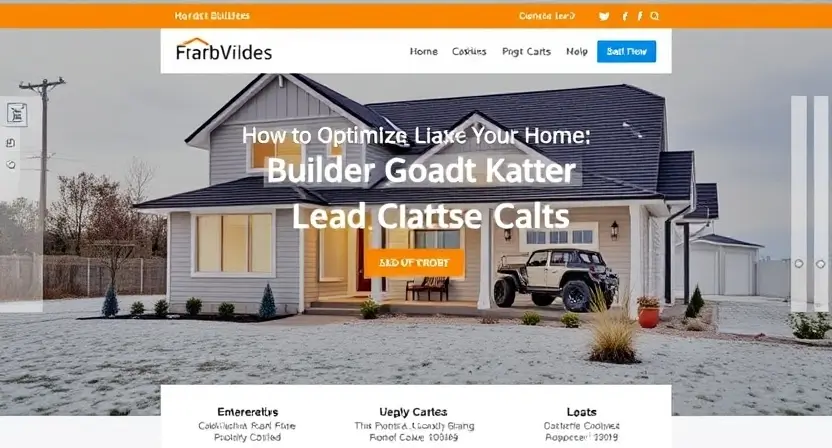In an industry as competitive as home building, a well-optimized website can be the difference between a steady stream of high-quality leads and a website that gets lost in the noise. Optimizing your home builder website for lead generation requires a strategic approach that blends user experience, SEO best practices, and compelling content. This comprehensive guide will walk you through actionable steps to transform your site into a powerful lead-generation tool.

1. Ensure a Mobile-Friendly Design
Over half of all web traffic comes from mobile devices, making a mobile-responsive design essential for capturing leads. A mobile-friendly site adapts seamlessly to different screen sizes and ensures that potential customers have a smooth browsing experience.
Example & Actionable Recommendation:
- Use responsive design frameworks (e.g., Bootstrap) to create a site that adjusts automatically to any screen size. For instance, home builder websites like “Smith Custom Homes” revamped their site using responsive design and saw a 40% increase in mobile leads within three months.
- Test your website on various devices and browsers to ensure it functions well across platforms.
- Optimize mobile page loading speed by compressing images, reducing server response times, and leveraging browser caching.
2. Improve Page Load Speed
Website visitors have little patience for slow-loading sites. Studies show that a delay of just one second can reduce conversions by 7%. Faster load times enhance user experience and positively impact SEO rankings.
Example & Actionable Recommendation:
- Use tools like Google PageSpeed Insights and GTmetrix to identify and fix speed issues. For example, a home builder in California optimized their website speed from 5 seconds to 2 seconds and saw a 25% increase in conversion rates.
- Compress images using tools like TinyPNG or ImageOptim.
- Minimize the use of heavy scripts and remove any unnecessary plugins.
- Implement a content delivery network (CDN) to serve content faster to users.
3. Create Compelling Landing Pages
Landing pages are critical for lead generation because they are designed with a single focus: converting visitors into leads. A well-optimized landing page can significantly increase your conversion rates.

Example & Actionable Recommendation:
- Ensure each landing page has a clear headline that conveys value. For instance, a headline like “Build Your Dream Home with Expert Precision” immediately communicates the benefit.
- Use bullet points to break down key benefits. For example, highlight unique features such as “custom design options” and “energy-efficient construction.”
- Include a strong call-to-action (CTA) that stands out visually (e.g., “Get Your Free Consultation”).
- Add trust signals like customer testimonials, industry certifications, and case studies to build credibility.
4. Optimize Forms for Better Conversion
Forms are the final step in converting a visitor into a lead, so they need to be optimized for ease of use. Overly complicated forms can discourage users from completing them.
Example & Actionable Recommendation:
- Limit the number of fields to only essential information (e.g., name, phone number, email). For example, a home builder in Texas simplified their contact form from 10 fields to 4 and saw a 50% increase in form submissions.
- Use inline form validation to help users correct errors in real-time.
- Place forms above the fold on important pages, such as landing pages and service pages.
- Test different form layouts (single-column vs. multi-column) to see which performs better for your audience.
5. Enhance Your Call-to-Action (CTA) Strategy
Your CTAs should guide your visitors through their journey on your site and prompt them to take action. The more effective and visible your CTAs, the more likely users will engage.
Example & Actionable Recommendation:
- Use action-oriented language, such as “Request Your Free Quote” or “Schedule Your Consultation.” For example, a home builder updated their CTAs with more dynamic language and saw a 20% improvement in click-through rates.
- Make CTAs stand out by using contrasting colors and large, clickable buttons.
- Place CTAs strategically throughout your site, including on blog posts, service pages, and at the end of guides.
6. Leverage Local SEO Techniques
Local SEO is a must for home builders, as most clients search for services in their immediate area. By optimizing for local search, you can attract more relevant traffic.
Example & Actionable Recommendation:
- Claim and optimize your Google Business Profile, ensuring all details are accurate and include targeted keywords. A home builder in Chicago who fully optimized their profile saw a 30% increase in local leads.
- Incorporate location-specific keywords throughout your site (e.g., “Custom Home Builders in [City/Region]”).
- Encourage satisfied clients to leave positive reviews, as these boost your local search ranking. For instance, 5-star reviews can push your business higher in local search results.
- Build local citations by ensuring your business name, address, and phone number (NAP) are consistent across online directories.
7. Add High-Quality, Informative Content
Content marketing can establish your expertise and provide valuable information to potential clients. Blog posts, guides, and project showcases can all serve as effective lead magnets.
Example & Actionable Recommendation:
- Publish articles that address common questions or concerns (e.g., “Top 5 Tips for Choosing a Home Builder”). A home builder who started a blog series answering common questions saw a 15% boost in website traffic.
- Use long-form content to delve into topics in-depth, which can improve dwell time and demonstrate your expertise.
- Include internal links to guide readers to service pages or contact forms.
- Create gated content such as eBooks or downloadable guides in exchange for contact information.
8. Incorporate Visual Elements and Video Content
Visuals play a huge role in engaging visitors and showcasing your work. For home builders SEO, high-quality images and videos can highlight past projects and illustrate your capabilities.
Example & Actionable Recommendation:
- Use professional photography to feature completed homes and ongoing projects. A home builder that added a video tour of completed projects saw a 35% increase in user engagement.
- Create video tours of homes, customer testimonials, or “behind-the-scenes” videos.
- Optimize images and videos by adding alt text and compressing files to improve load times.
9. Integrate Chatbots and Live Chat Features
Real-time communication tools like chatbots and live chat can capture leads who may not be ready to fill out a form but have questions they need answered.

Example & Actionable Recommendation:
- Integrate a live chat option that’s available during business hours. For example, a home builder who added a chatbot feature captured 15% more leads through chat interactions.
- Use chatbots to provide automated responses to common queries and capture visitor details.
- Ensure chat interactions have an option for visitors to request follow-up contact.
10. Showcase Testimonials and Social Proof
Social proof builds trust and shows potential clients that others have had positive experiences with your business.
Example & Actionable Recommendation:
- Add a dedicated testimonials section or integrate quotes throughout your site. A builder that showcased client stories saw a 25% increase in contact form submissions.
- Use video testimonials for a more authentic and engaging experience.
- Display review badges from third-party platforms like Google or Yelp.
11. Utilize Schema Markup for Rich Snippets
Schema markup helps search engines understand your content better, which can improve how your site appears in search results and lead to rich snippets.
Example & Actionable Recommendation:
- Implement schema markup for reviews, services, FAQs, and projects. For instance, a home builder that added schema markup for their reviews noted higher click-through rates from search results.
- Use tools like Schema.org’s markup generator to create structured data.
- Regularly test your structured data with Google’s Rich Results Test tool.
12. Monitor and Adjust Your Strategy
Optimization isn’t a one-and-done effort. Regularly tracking your website’s performance helps you understand what’s working and what needs adjustment.
Example & Actionable Recommendation:
- Set up Google Analytics and track key metrics like bounce rate, session duration, and conversion rate. A home builder that used heatmaps found that most users ignored their sidebar CTA, leading them to reposition it for better visibility.
- Use heatmaps (e.g., Hotjar or Crazy Egg) to analyze user behavior on your site.
- A/B test different elements like CTAs, form designs, and landing pages to determine the most effective version.
- Stay updated with the latest SEO trends and algorithm updates to maintain optimal performance.
Conclusion
Optimizing your home builder website for lead generation involves a multi-faceted approach that integrates user experience enhancements, strategic SEO practices, and engaging content creation. From ensuring mobile-friendliness and fast page load speeds to incorporating high-quality visuals and leveraging local SEO, each element contributes to creating a seamless and appealing user journey. Implementing effective CTAs, simplifying forms, and using social proof help convert visitors into leads, while continuous monitoring and adjusting ensure your strategies remain effective over time. By following these actionable steps, your website can become a powerful tool that not only attracts more visitors but successfully converts them into long-term clients, solidifying your position in a competitive market.



Pingback: How Local SEO Can Drive More Leads for Home Builders
Pingback: Top 30 Construction SEO Trends You Need to Know in 2025
Pingback: Top 10 SEO Tips! Every General Contractor Should Know
Pingback: How Much Do Home Builders Make? Salary Insights and Earning